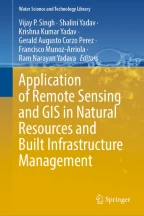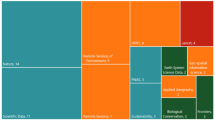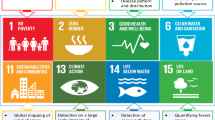Applications of Geospatial and Information Technologies Toward Achieving Sustainable Development Goals

Sustainable development is possible by holistically prioritizing urban and rural development activities by capturing many complexities, constraints, and livelihood opportunities. In this context, United Nations (UN) designed a blueprint containing seventeen interlinked Sustainable Development Goals (SDGs) to address the global challenges, including climate change, environmental degradation, peace, poverty, inequality, and justice. The achievement of SDGs and their universality would be possible through readily available data from affordable sources such as remote sensing images and readily available sources. The spatio–temporal data analysis is crucial for assessing, monitoring, and decision-making and becomes integral in addressing SDG indicators. However, the advancement and availability of an enormous amount of earth observation data increased the need for new methods and techniques. Nowadays, the integration of geospatial technologies along with information and communication technology (ICT) like the Internet of Things (IoT), big data, machine learning (ML), artificial intelligence (AI), advanced sensor networking, and crowdsourcing has made a powerful analytic platform for Spatial Decision Support System (SDSS). This chapter comprehensively reviews and documents the scope and application of geospatial and information and communication technology and its role in action plan formulation toward achieving SDGs.
This is a preview of subscription content, log in via an institution to check access.
Access this chapter
Subscribe and save
Springer+ Basic
€32.70 /Month
- Get 10 units per month
- Download Article/Chapter or eBook
- 1 Unit = 1 Article or 1 Chapter
- Cancel anytime
Buy Now
Price includes VAT (France)
eBook EUR 117.69 Price includes VAT (France)
Softcover Book EUR 158.24 Price includes VAT (France)
Hardcover Book EUR 158.24 Price includes VAT (France)
Tax calculation will be finalised at checkout
Purchases are for personal use only
Similar content being viewed by others

Conclusion: Spatial Information Technology for Sustainable Development Goals
Chapter © 2019

A review of scientific advancements in datasets derived from big data for monitoring the Sustainable Development Goals
Article 04 June 2021

Utilizing geospatial information to implement SDGs and monitor their Progress
Article 11 December 2019
Abbreviations
Automatic identification system
Gross domestic product
Global positioning system
International business machines
Information and communication technology
Internet of things
Land surface temperature
Massive open online courses
Regional space applications programme for sustainable development
Sustainable development goals index
Sustainable development goals
Sustainable development solutions network
Spatial decision support system
Small island developing states
United Nations economic and social commission for Asia and the Pacific
Volunteered geographic information
References
- Acharya TD, Lee DH (2019) Remote sensing and geospatial technologies for sustainable development: a review of applications. Sens Mater 31(11):3931–3945 Google Scholar
- Arroyo JA, Gomez-Castaneda C, Ruiz E, de Cote EM, Gavi F, Sucar LE (2017) UAV technology and machine learning techniques applied to the yield improvement in precision agriculture. In: 2017 IEEE Mexican humanitarian technology conference (MHTC). IEEE, pp 137–143 Google Scholar
- Asensio S (1997) Targeting the poor-poverty indicators in a spatial context. M.Sc. thesis. ITC, The Netherlands Google Scholar
- Avtar R, Tripathi S, Aggarwal AK, Kumar P (2019) Population–urbanization–energy nexus: a review. Resources 8(3):136 ArticleGoogle Scholar
- Bi WL, Hosny A, Schabath MB, Giger ML, Birkbak NJ, Mehrtash A, Allison T, Arnaout O, Abbosh C, Dunn IF (2019) Artificial intelligence in cancer imaging: clinical challenges and applications. CA Can J Clin 69:127–157 Google Scholar
- Bonaiuto M, Fornara F, Ariccio S, Cancellieri UG, Rahimi L (2015) Perceived residential environment quality indicators (PREQIs) relevance for UN-HABITAT city prosperity index (CPI). Habitat Int 45:53–63 ArticleGoogle Scholar
- Dahdouh-Guebas F (2002) The use of remote sensing and GIS in the sustainable management of tropical coastal ecosystems. In: Environment, development and sustainability, vol 4. https://doi.org/10.1023/A:1020887204285
- Daiman A, Goyal S (2020) Geo-spatial approach based mapping using proximity analysis techniques for establishment of new higher education colleges—a case study of chambal division, Madhya Pradesh, India. Asian J Multidimension Res (AJMR) 9(2):237–246 ArticleGoogle Scholar
- Dangermond BJ, Artz M (2010) Climate change is a geographic problem the geographic approach to climate change. ESR I:32 Google Scholar
- Decuyper M, Chávez RO, Čufar K, Estay SA, Clevers JG, Prislan P, Sass-Klaassen U et al (2020) Spatio-temporal assessment of beech growth in relation to climate extremes in Slovenia—an integrated approach using remote sensing and tree-ring data. Agric For Meteorol 287:107925 Google Scholar
- Dovey K (2015) Sustainable informal settlements? Proc Soc Behav Sci 179:5–13. https://doi.org/10.1016/j.sbspro.2015.02.406
- Eagle N, Macy M, Claxton R (2010) Network diversity and economic development. Science 328(5981):1029 LP-1021031 Google Scholar
- El-Batran M, Arandel C (2005) A shelter of their own: informal settlement expansion in greater Cairo and government responses. Environ Urban 10(1):217–232. https://doi.org/10.1630/095624798101284392ArticleGoogle Scholar
- Elias P, Benekos G, Perrou T, Parcharidis I (2020) Spatio-temporal assessment of land deformation as a factor contributing to relative sea level rise in coastal urban and natural protected areas using multi-source earth observation data. Rem Sens 12(14):2296 ArticleGoogle Scholar
- Elvidge CD, Sutton PC, Ghosh T, Tuttle BT, Baugh KE, Bhaduri B, Bright E (2009) A global poverty map derived from satellite data. Comput Geosci 35(8):1652–1660. https://doi.org/10.1016/j.cageo.2009.01.009ArticleGoogle Scholar
- ESRI. https://learn.arcgis.com/en/paths/solve-problems-for-sustainable-development-goals
- Ferguson RL, Korfmacher K (1997) Remote sensing and GIS analysis of seagrass meadows in North Carolina, USA. Aquat Bot 58(3–4):241–258. https://doi.org/10.1016/S0304-3770(97)00038-7ArticleGoogle Scholar
- Ganguly K, Modi M, Saxena MR, Bharadwaj R, Divya VV, Rajiv K, Shankar GR, Shankar TR, Bhanumurthy V, Murthy YVNK (2017) A multi-scale feature extraction approach to improve land use land/cover classification accuracy using IRS LISS-IV imagery. Rem Sens Land 1(1):3–17. https://doi.org/10.21523/gcj1.16010101
- Ganguly K, Shabnam S, Das S, Mitran T (2021) Assessment of Urban sprawl impact on agricultural land use using geospatial techniques. In: Mitran T, Meena RS, Chakraborty A (eds) Geospatial technologies for crops and soils. Springer, Singapore. https://doi.org/10.1007/978-981-15-6864-0_14
- Habitat U (2015) Governing council of the United Nations settlements programme, twenty fifth session Nairobi, 17–23 Apr 2015 item 6 of the provisional agenda Google Scholar
- Hák T, Janoušková S, Moldan B (2016) Sustainable development goals: a need for relevant indicators. Ecol Ind 60:565–573 ArticleGoogle Scholar
- Haslauer E, Biberacher M, Blaschke T (2012) GIS-based backcasting: an innovative method for parameterization of sustainable spatial planning and resource management. Futures 44(4):292–302. https://doi.org/10.1016/j.futures.2011.10.012ArticleGoogle Scholar
- Huntingford C, Jeffers ES, Bonsall MB, Christensen HM, Lees T, Yang H (2019) Machine learning and artificial intelligence to aid climate change research and preparedness. Rem Sens Lett 14:124007 Google Scholar
- Istepanian RSH, Al-Anzi T (2018) m-Health 2.0: new perspectives on mobile health, machine learning and big data analytics. Methods 151:34–44 ArticleCASGoogle Scholar
- Ivić M (2019) Artificial intelligence and geospatial analysis in disaster management. Int Arch Photogram Rem Sens Spat Inf Sci XLII-3/W8 Google Scholar
- Kaab A, Huggel C, Fischer L (2006) Remote sensing technologies for monitoring climate change impacts on glacier- and permafrost-related hazards. In: ECI conference on geohazards, vol 10 Google Scholar
- Karanja I (2010) An enumeration and mapping of informal settlements in Kisumu, Kenya, implemented by their inhabitants. Environ Urban 22(1):217–239. https://doi.org/10.1177/0956247809362642ArticleGoogle Scholar
- Khanna A, Kaur S (2020) Internet of things (IoT), applications and challenges: a comprehensive review. Wirel Pers Commun 114:1687–1762. https://doi.org/10.1007/s11277-020-07446-4ArticleGoogle Scholar
- Kharas H, Prizzon A, Rogerson A (2014) Financing the post-2015 sustainable development goals. Overseas Development Institute, London Google Scholar
- Kuffer M, Wang J, Nagenborg M, Pfeffer K, Kohli D, Sliuzas R, Persello C (2018) The scope of earth observation to improve the consistency of the SDG slum indicator. ISPRS Int J Geo Inf 7(11):428. https://doi.org/10.3390/ijgi7110428ArticleGoogle Scholar
- Kusumaningtyas R, Kobayashi S, Takeda S (2009) The impact of local community agricultural practices on livelihood security and forest degradation around the Tesso Nilo national park in Riau Province, Sumatra, Indonesia. Tropics 18(2):45–55. https://doi.org/10.3759/tropics.18.45ArticleGoogle Scholar
- Laney D (2001) 3D data management: controlling data volume, velocity and variety. META Group Res Note 6(70):1 Google Scholar
- Liu J, Fritz S, Van Wesenbeeck CFA, Fuchs M, You L, Obersteiner M, Yang H (2008) A spatially explicit assessment of current and future hotspots of hunger in sub-Saharan Africa in the context of global change. Glob Planet Chang 64(3–4):222–235. https://doi.org/10.1016/j.gloplacha.2008.09.007
- Liu P (2015) A survey of remote-sensing big data. Front Environ Sci 3:45. https://doi.org/10.3389/fenvs.2015.00045ArticleGoogle Scholar
- Lüge T, Sudhoff RS, Lessard-Fontaine A, de la Borderie S, Soupart M (2014) GIS support for the MSF Ebola response in Guinea in 2014 case study. Médecins Sans Frontieres Operational Center, Geneva Google Scholar
- Lwin KK, Sekimoto Y, Takeuchi W, Zettsu K (2019) City geospatial dashboard: IoT and big data analytics for geospatial solutions provider in disaster management. In: 2019 international conference on information and communication technologies for disaster management (ICT-DM). IEEE, pp 1–4 Google Scholar
- Machiwal D, Jha MK, Mal BC (2011) Assessment of groundwater potential in a semi-arid region of India using remote sensing, GIS and MCDM techniques. Water Resour Manage 25(5):1359–1386. https://doi.org/10.1007/s11269-010-9749-yArticleGoogle Scholar
- Maes WH, Steppe K (2019) Perspectives for remote sensing with unmanned aerial vehicles in precision agriculture. Trends Plant Sci 24(2):152–164 ArticleCASGoogle Scholar
- Maude RJ, Nguon C, Ly P, Bunkea T, Ngor P, Canavati De La Torre SE et al (2014) Spatial and temporal epidemiology of clinical malaria in Cambodia 2004–2013. Malar J 13(1):1–15. https://doi.org/10.1186/1475-2875-13-385ArticleGoogle Scholar
- Meadows DH, Meadows DH, Randers J, Behrens WW III (1972) The limits to growth: a report to the club of Rome (1972), p 91 Google Scholar
- Meadows DH, Randers J, Meadows DL (2013) The limits to growth (1972). In: The future of nature. Yale University Press, pp 101–116 Google Scholar
- Mishra S, Singh N, Bhattacharya D (2021) Application-based COVID-19 micro-mobility solution for safe and smart navigation in pandemics. ISPRS Int J Geo Inf 10(8):571 ArticleGoogle Scholar
- Mitran T, Meena RS, Chakraborty A (2021a) Geospatial technologies for crops and soils: an overview. In: Geospatial technologies for crops and soils, pp 1–48 Google Scholar
- Mitran T, Meena RS, Chakraborty A (eds) (2021b) Geospatial technologies for crops and soils. Springer Nature Singapore Pte Limited Google Scholar
- Nhamo L, Van Dijk R, Magidi J, Wiberg D, Tshikolomo K (2018) Improving the accuracy of remotely sensed irrigated areas using post-classification enhancement through UAV capability. Rem Sens 10(5):712 ArticleGoogle Scholar
- Okwi PO, Ndeng’e G, Kristjanson P, Arunga M, Notenbaert A, Omolo A et al (2007) Spatial determinants of poverty in rural Kenya. Proc Natl Acad Sci 104(43):16769–16774. https://doi.org/10.1073/pnas.0611107104
- Orimoloye IR, Mazinyo SP, Nel W, Kalumba AM (2018) Spatiotemporal monitoring of land surface temperature and estimated radiation using remote sensing: human health implications for East London, South Africa. Environ Ear Sci 77(3):1–10. https://doi.org/10.1007/s12665-018-7252-6ArticleGoogle Scholar
- Paulson B (1992) Urban applications of remote sensing and GIS analysis. In: Urban management programme Google Scholar
- Quinteiro P, Rafael S, Vicente B, Marta-Almeida M, Rocha A, Arroja L, Dias AC (2019) Mapping green water scarcity under climate change: a case study of Portugal. Sci Total Environ 696:134024 ArticleCASGoogle Scholar
- Reddy SC, Jha CSS, Dadhwal VKK, Hari Krishna P, Vazeed Pasha S, Satish KVV et al (2016) Quantification and monitoring of deforestation in India over eight decades (1930–2013). Biodivers Conserv 25(1):93–116. https://doi.org/10.1007/s10531-015-1033-2ArticleGoogle Scholar
- Riitters K, Wickham J, Costanza JKK, Vogt P (2016) A global evaluation of forest interior area dynamics using tree cover data from 2000 to 2012. Landscape Ecol 31(1):137–148. https://doi.org/10.1007/s10980-015-0270-9ArticleGoogle Scholar
- Rosero-Bixby L (2004) Spatial access to health care in Costa Rica and its equity: a GIS-based study. Soc Sci Med 58(7):1271–1284. https://doi.org/10.1016/S0277-9536(03)00322-8ArticleGoogle Scholar
- Sachs J, Schmidt-Traub G, Kroll C, Lafortune G, Fuller G, Woelm F (2020) The sustainable development goals and COVID-19. Sustainable Development Report. https://www.sdgindex.org/reports/sustainable-development-report-2020/
- Saitoh SIS-II, Mugo R, Radiarta INN, Asaga S, Takahashi F, Hirawake T et al (2011) Some operational uses of satellite remote sensing and marine GIS for sustainable fisheries and aquaculture. ICES J Mar Sci 68(4):687–695. https://doi.org/10.1093/icesjms/fsq190ArticleGoogle Scholar
- Saraf AK, Choudhury PR (1998) Integrated remote sensing and GIS for groundwater exploration and identification of artificial recharge sites. Int J Rem Sens 19(10):1825–1841. https://doi.org/10.1080/014311698215018ArticleGoogle Scholar
- Soto V, Frías-Martínez E (2011) Automated land use identification using cell-phone records. In: Proceedings of the 3rd ACM international workshop on MobiArch, pp 17–22 Google Scholar
- Tatem AJJ, Bird TJJ, Bjelland J, Bengtsson L, Alegana VAA, Iqbal AMM et al (2017) Mapping poverty using mobile phone and satellite data. J R Soc Interface 14(127):20160690. https://doi.org/10.1098/rsif.2016.0690ArticleGoogle Scholar
- Thapa RB, Motohka T, Watanabe M, Shimada M (2015) Time-series maps of aboveground carbon stocks in the forests of central Sumatra. Carbon Balance Manage 10(1):1–13. https://doi.org/10.1186/s13021-015-0034-5ArticleCASGoogle Scholar
- Topol EJ (2019) High-performance medicine: the convergence of human and artificial intelligence. Nat Med 25(1):44–56 ArticleCASGoogle Scholar
- Trinidad JE (2022) Spatial analysis of high school dropout: the role of race, poverty, and outliers in New York City Google Scholar
- Ulugtekin N, Bektas F, Dogru AO, Goksel C, Alaton IA (2005) The use of remote sensing and GIS technologies for comprehensive wastewater management. In: International symposium on remote sensing of environment, global monitoring for sustainable and security. https://www.isprs.org/proceedings/2005/isrse/html/papers/483.pdf
- United Nations (2016) The sustainable development goals 2016. eSocialSciences Google Scholar
- Vinuesa R, Azizpour H, Leite L, Balaam M, Dignum V, Domisch S, Felländer A, Langhans SD, Tegmark M, Nerini FF (2020) The role of artificial intelligence in achieving the sustainable development goals. Nat Commun 11(233). https://doi.org/10.1038/s41467-019-14108-y
- VoPham T, Hart JE, Laden F, Chiang YY (2018) Emerging trends in geospatial artificial intelligence (geoAI): potential applications for environmental epidemiology. Environ Health 17(1):40 ArticleGoogle Scholar
- Wang X, Zhang F, Ding J (2017) Evaluation of water quality based on a machine learning algorithm and water quality index for the Ebinur Lake Watershed, China. Sci Rep 7(1):1–18 Google Scholar
- World Economic Forum (2021) IoT for sustainable development project. https://widgets.weforum.org/iot4d/index.html
- Yu F, Sun W, Li J, Zhao Y, Zhang Y, Chen G (2017) An improved Otsu method for oil spill detection from SAR images. Oceanologia 59(3):311–317 ArticleGoogle Scholar
Author information
Authors and Affiliations
- Cognizant Technology Solutions, Hyderabad, 500001, India Srabani Das & Kuntal Ganguly
- Soil and Land Resources Assessment Division, National Remote Sensing Centre, ISRO, Hyderabad, Telangana, 500037, India Tarik Mitran
- Environmental System Research Institute, India, Ecospace, Kolkata, 700091, India Surya Deb Chakraborty
- Srabani Das



